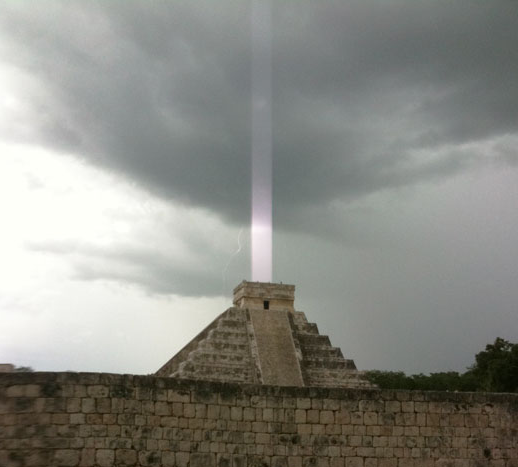Mayan Light Beam Photo: Message from Gods, or iPhone Glitch?

When Hector Siliezar visited the ancient Mayan city of Chichen Itza with his wife and kids in 2009, he snapped three iPhone photos of El Castillo, a pyramid that once served as a sacred temple to the Mayan god Kukulkan. A thunderstorm was brewing near the temple, and Siliezar was trying to capture lightning crackling dramatically over the ruins.
In the first two images, dark clouds loom above the pyramid, but nothing is amiss. However, in the third photo, a powerful beam of light appears to shoot up from the pyramid toward the heavens, and a thunderbolt flashes in the background.
Siliezar, who recently shared his photographs with occult investigators, told Earthfiles.com that he and his family didn't see the light beam in person; it appeared only on camera. "It was amazing!" he said. He showed the iPhone photo to his fellow tourists. "No one, not even the tour guide, had ever seen anything like it before." [See photo]
The photo has surfaced on several Mayan doomsday discussion forums. But was the light beam a sign from the gods — a warning about Dec. 21, 2012, the date that marks the end of the Mayan calendar cycle, and when some people fear the world will end? Or is it simply the result of an iPhone glitch?
According to Jonathon Hill, a research technician and mission planner at the Mars Space Flight Facility at Arizona State University, which operates many of the cameras used during NASA's Mars missions, it is almost definitely the latter. Hill works with images of the Martian surface taken by rovers and satellites, as well as data from Earth-orbiting NASA instruments, and is fully versed in the wide range of potential image artifacts and equipment errors.
He says the "light beam" in the Mayan temple photo is a classic case of such an artifact — a distortion in an image that arises from the way cameras bounce around incoming light.
It is no mere coincidence, Hill said, that "of the three images, the 'light beam' only occurs in the image with a lightning bolt in the background. The intensity of the lightning flash likely caused the camera's CCD sensor to behave in an unusual way, either causing an entire column of pixels to offset their values or causing an internal reflection [off the] camera lens that was recorded by the sensor." In either case, extra brightness would have been added to the pixels in that column in addition to the light hitting them directly from the scene. [7 Things that Cause UFO Sightings]
Sign up for the Live Science daily newsletter now
Get the world’s most fascinating discoveries delivered straight to your inbox.
Evidence in favor of this explanation is the fact that the beam, when isolated in Photoshop or other image analysis software, runs perfectly vertical in the image. "That's a little suspicious since it's very unlikely that the gentleman who took this picture would have his handheld iPhone camera positioned exactly parallel to the 'light beam' down to the pixel level," Hill told Life's Little Mysteries.
It's more likely that the "light beam" corresponds to a set of columns of pixels in the camera sensor that are electronically connected to each other, but not to other columns in the sensor, and that this set of connected pixels became oversaturated in the manner described above.
"That being said," Hill said, "it really is an awesome image!"
Follow Natalie Wolchover on Twitter @nattyover. Follow Life's Little Mysteries on Twitter @llmysteries, then join us on Facebook.
Natalie Wolchover was a staff writer for Live Science from 2010 to 2012 and is currently a senior physics writer and editor for Quanta Magazine. She holds a bachelor's degree in physics from Tufts University and has studied physics at the University of California, Berkeley. Along with the staff of Quanta, Wolchover won the 2022 Pulitzer Prize for explanatory writing for her work on the building of the James Webb Space Telescope. Her work has also appeared in the The Best American Science and Nature Writing and The Best Writing on Mathematics, Nature, The New Yorker and Popular Science. She was the 2016 winner of the Evert Clark/Seth Payne Award, an annual prize for young science journalists, as well as the winner of the 2017 Science Communication Award for the American Institute of Physics.










